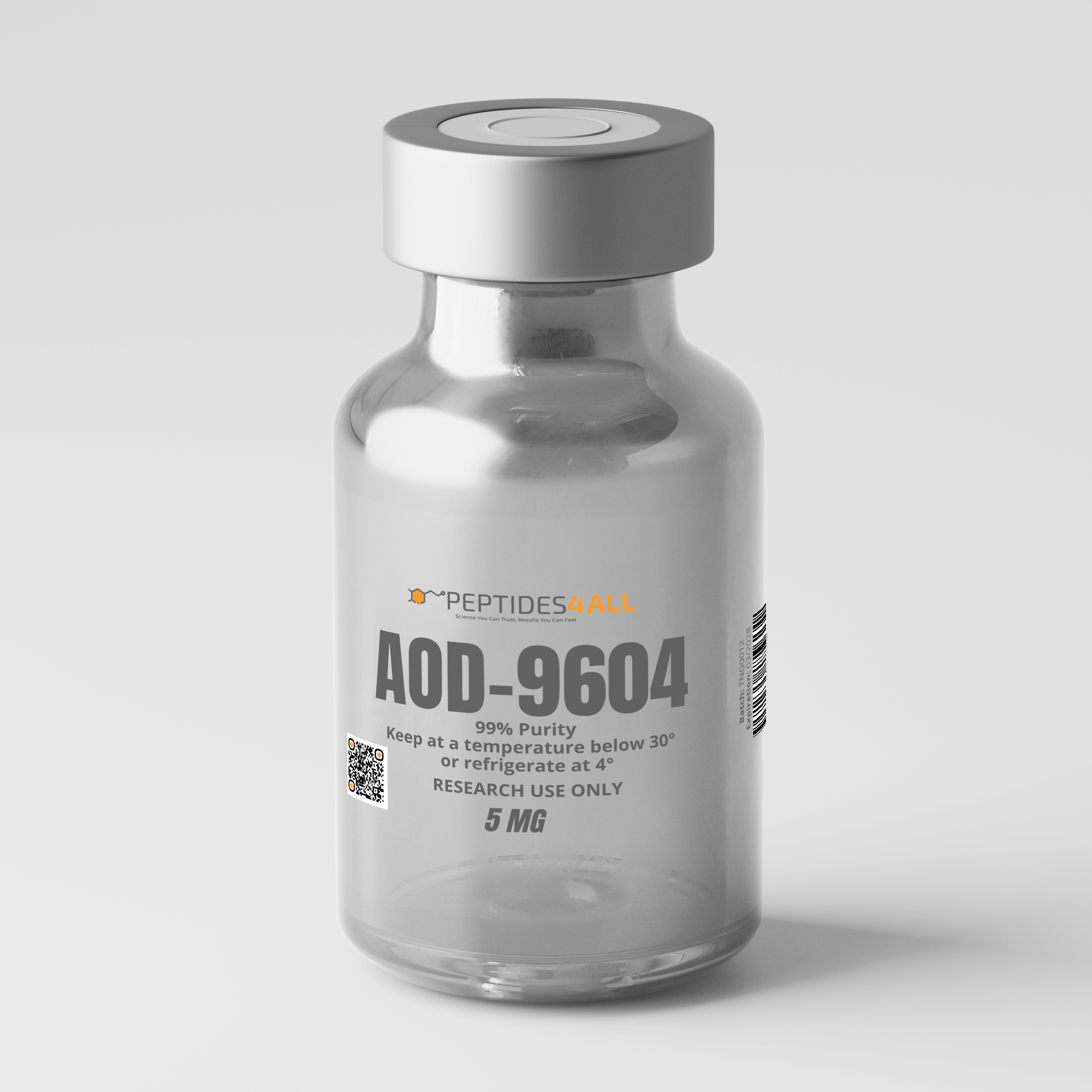PEPTIDES4ALL AOD-9604 – Lipolytic Peptide Fragment for Metabolic & Regenerative Research
PEPTIDES4ALL AOD-9604 is a synthetic peptide fragment derived from the C-terminal region (residues 177–191) of human growth hormone (hGH), designed to retain the fat-burning (lipolytic) effects of GH while eliminating its growth-promoting and metabolic side effects. This modification allows researchers to explore fat metabolism, energy balance, and tissue regeneration without the complications associated with full-length growth hormone or elevated IGF-1 signaling.
Unlike hGH, which exerts broad anabolic activity through multiple receptor pathways, AOD-9604 selectively targets metabolic and lipolytic processes. It enhances lipolysis (the breakdown of stored fat) while inhibiting lipogenesis (the formation of new fat cells), effectively promoting a leaner metabolic profile. Importantly, it achieves this without significantly impacting insulin sensitivity, glucose regulation, or IGF-1 levels, making it a unique model for studying weight regulation and metabolic safety.
Research in preclinical models has demonstrated that AOD-9604 reduces adiposity, stimulates fat oxidation, and increases β3-adrenergic receptor expression in adipose tissue, amplifying the body’s natural ability to utilize stored fat for energy (Endocrinology, 2001). Furthermore, studies have revealed cartilage-protective and regenerative effects, with enhanced joint preservation and repair observed in osteoarthritis models when AOD-9604 was used alone or in combination with hyaluronic acid (PubMed).
Because of its selective activity and strong safety profile, AOD-9604 has become a valuable compound for metabolic and regenerative research, particularly in the study of obesity, cartilage degeneration, energy metabolism, and tissue repair.
With its high-purity lyophilized formulation and favorable pharmacological characteristics, PEPTIDES4ALL AOD-9604 provides researchers with a powerful and reproducible tool to investigate non-anabolic pathways of fat metabolism and the potential therapeutic mechanisms of regenerative peptides.
Scientific Evidence & Research Findings
-
Stimulates Fat Breakdown (Lipolysis) – In rodent models, AOD-9604 significantly reduced body fat and improved fat oxidation, mimicking GH’s lipolytic effects without elevating insulin or IGF-1 levels. https://pubmed.ncbi.nlm.nih.gov/11713213/
-
Inhibits Fat Creation (Lipogenesis) – The peptide has shown the capacity to reduce the formation of new fat stores in adipocytes and liver cells, complementing its fat breakdown effects. https://jofem.org/index.php/jofem/article/view/213/278
-
Increases β3-Adrenergic Receptor Expression – In obese mice, AOD-9604 upregulated β3-AR mRNA in fat tissue, enhancing sensitivity to fat metabolism signals. https://academic.oup.com/endo/article-pdf/142/12/5182/10363052/endo5182.pdf
-
Joint & Cartilage Support – In rabbit osteoarthritis models, intra-articular injection of AOD-9604 improved cartilage preservation and regeneration, particularly when combined with hyaluronic acid (HA). https://pubmed.ncbi.nlm.nih.gov/26275694/
-
Safe Metabolic Profile – In several human and animal safety studies, AOD-9604 did not increase IGF-1 or significantly disrupt glucose/insulin metabolism, suggesting a favorable safety margin compared to GH therapies. https://jofem.org/index.php/jofem/article/view/157/195
Key Research Benefits & Applications
-
Selective Fat Metabolism Modulation: Stimulates lipolysis (fat breakdown) while inhibiting lipogenesis (fat creation), offering a precise model for studying adipose metabolism independent of GH’s anabolic actions.
-
β3-Adrenergic Pathway Activation: Upregulates β3-adrenergic receptors in adipose tissue, enhancing responsiveness to catecholamines and increasing fatty-acid oxidation and energy expenditure.
-
Non-Anabolic Metabolic Profile: Unlike full-length growth hormone, AOD-9604 does not elevate IGF-1 or disrupt glucose homeostasis, providing a safer model for metabolic and obesity research.
-
Cartilage & Connective-Tissue Regeneration: Promotes cartilage preservation, chondrocyte proliferation, and joint recovery in osteoarthritis and tissue-repair models—especially when combined with hyaluronic acid.
-
Anti-Inflammatory & Regenerative Synergy: Supports tissue regeneration and repair under metabolic stress, complementing its lipid-regulating functions with mild anti-inflammatory effects.
-
Applications in Metabolic & Regenerative Studies: Serves as a non-anabolic peptide framework for exploring obesity mechanisms, energy utilization, musculoskeletal repair, and peptide-based metabolic interventions.
Presentation & Handling
- Form: Supplied as lyophilized peptide in sterile vial.
- Reconstitution: Use bacteriostatic water or 2% procaine; swirl gently (do not shake vigorously).
- Storage: Store at –20 °C, protected from light and moisture. After reconstitution, use according to research protocols and handle under sterile conditions.
Intended Use
For research purposes only. Must be handled in accordance with institutional protocols and ethical guidelines.
